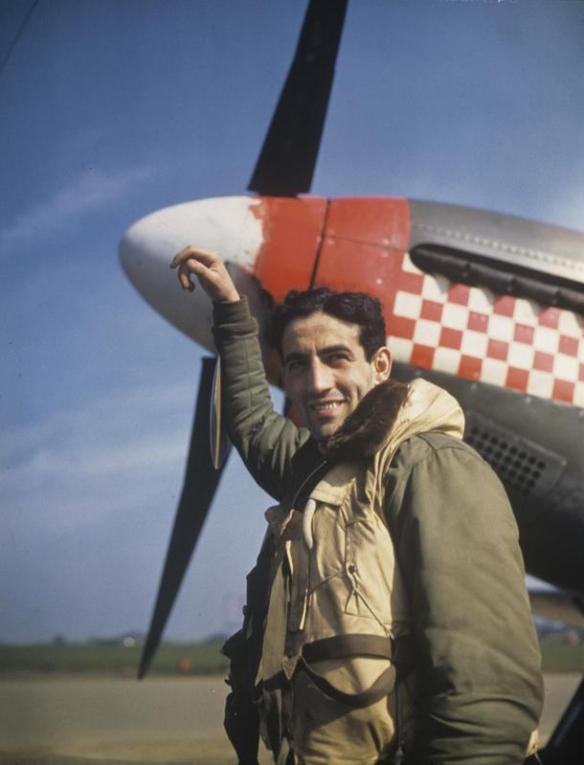A pilot, Domenic “Don” Gentile, of the 336th Fighter Squadron, 4th Fighter Group – Debden with his P-51 Mustang, nicknamed “Shangri-La”
Jug pilots emerged as the top aces of the 8th Air Force, notwithstanding the basic superiority of the Mustang. The fact was that by the time that the Mustang was in widespread service, the German fighter arm was short of experienced pilots and beset by fuel shortages. This meant that Jug pilots generally had more opportunities, while in the later stages of the war some Mustang pilots never even saw an enemy aircraft in the air.
Statistics tell part of the story. In all, some 5,000 fighter pilots flew with 8th Air Force during the war. Of these, nearly 2,900 claimed nothing. Only 261 (5.2%) scored five victories or more, while 57 (2.6%) scored more than ten.
From the middle of the war, American fighter pilots were better trained, and had had more hours on type before entering combat, than those of any other nation. They were tremendously professional. Bud Mahurin of the 56th FG recalled ‘sitting in the sack’ for hours on end, thinking over what he would do in certain hypothetical situations. His dedication certainly paid off; in 85 sorties he shot down 21 German aircraft before himself being shot down over France by a Dornier gunner. In the Pacific he added one Japanese bomber, and in Korea three and a half MiG-15s. By contrast, the German training programme was bedevilled by fuel shortages, and the newly fledged pilots reaching the Jagdgeschwader were of increasingly indifferent quality.
The top-scoring Lightning pilots in the 8th Air Force, with nine apiece, were Robin Olds, who scored a further five while flying Mustangs, and William Morris. Over 20 years later, Olds knocked down four MiGs over Vietnam, where he gained a legendary reputation for his ability to keep track of a fast-moving combat.
The basic USAAF fighter element was the pair, consisting of the leader (shooter) and the wingman (defender). This held good throughout the war, with one notable exception. The 4th FG team of Don Gentile (22 victories) and John Godfrey (18 victories) became legendary for their use of what later became Fluid Two tactics, in which leadership passed from one to the other as required. It should be noted, however, that in multi-bogey fights they stayed with the orthodox welded wing doctrine. Fluid Two could only occur after the squadron formation had broken up, allowing small scale engagements of two-versus-two or two-versus-one to take place. While often compared to teams from legend such as Jonathan and David, or Damon and Pythias, the fact is that Gentile and Godfrey flew together as a pair only about five times.
No fighter pilot is fearless, but few have described the feelings encountered in combat as graphically as Gentile:
And once the enemy has got you and is clobbering you, that’s slow too. It’s like lighted matches being slowly dragged across the bunched-up flesh of your brain pan. It feels like your brain is slowly dissolving under the pain on top of it. It’s a fight to keep your brain together, and while you’re fighting this fight, putting, it seems, your two hands on your mind and holding it with all the strength in your fingers, how long it seems to last and how far away the end you want seems to be.
I’ve had help in fighting this kind of fight from two Huns with whom I struck up a brief acquaintance on separate occasions. Each fought very well. They were crafty and had courage. One of them I thought was going to be real serious trouble for me. The other I thought was going to be able to get away to fight another day.
But suddenly, I don’t know, something happened in their minds. You could see it plainly. Their brains dissolved under the pressure of fear and had become just dishwater in their heads. They froze to their sticks and straightened out and ran right into their graves like men stricken blind who run, screaming, off a cliff.
It is hard to avoid the conclusion that these two opponents of Gentile actually gave up before they were fatally hit. Their aggression failed; their determination melted away, and even their basic survival instinct deserted them. As Gentile clearly indicates, self-control under pressure is the primary requisite of a fighter pilot.
